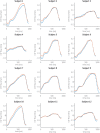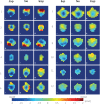Phase contrast MRI measurements of net cerebrospinal fluid flow through the cerebral aqueduct are confounded by respiration
- PMID: 29741818
- PMCID: PMC6519345
- DOI: 10.1002/jmri.26181
Phase contrast MRI measurements of net cerebrospinal fluid flow through the cerebral aqueduct are confounded by respiration
Abstract
Background: Net cerebrospinal fluid (CSF) flow through the cerebral aqueduct may serve as a marker of CSF production in the lateral ventricles, and changes that occur with aging and in disease.
Purpose: To investigate the confounding influence of the respiratory cycle on net CSF flow and stroke volume measurements.
Study type: Cross-sectional study.
Subjects: Twelve young, healthy subjects (seven male, age range 19-39 years, average age 28.3 years).
Field strength/sequence: Phase contrast MRI (PC-MRI) measurements were performed at 7T, with and without respiratory gating on expiration and on inspiration. All measurements were repeated.
Assessment: Net CSF flow and stroke volume in the aqueduct, over the cardiac cycle, was determined.
Statistical tests: Repeatability was determined using the intraclass correlation coefficient (ICC) and linear regression analysis between the repeated measurements. Repeated measures analysis of variance (ANOVA) was performed to compare the measurements during inspiration/expiration/no gating. Linear regression analysis was performed between the net CSF flow difference (inspiration minus expiration) and stroke volume.
Results: Net CSF flow (average ± standard deviation) was 0.64 ± 0.32 mL/min (caudal) during expiration, 0.12 ± 0.49 mL/min (cranial) during inspiration, and 0.31 ± 0.18 mL/min (caudal) without respiratory gating. Respiratory gating did not affect stroke volume measurements (41 ± 18, 42 ± 19, 42 ± 19 μL/cycle for expiration, no respiratory gating and inspiration, respectively). Repeatability was best during inspiration (ICC = 0.88/0.56/-0.31 for gating on inspiration/expiration/no gating). A positive association was found between average stroke volume and net flow difference between inspiration and expiration (R = 0.678/0.605, P = 0.015/0.037 for the first/second repeated measurement).
Data conclusion: Measured net CSF flow is confounded by respiration effects. Therefore, net CSF flow measurements with PC-MRI cannot in isolation be directly linked to CSF production.
Level of evidence: 1 Technical Efficacy: Stage 2 J. Magn. Reson. Imaging 2019;49:433-444.
Keywords: 7T MRI; CSF stroke volume; aqueduct of Sylvius; cerebral aqueduct; cerebrospinal fluid; net CSF flow.
© 2018 The Authors Journal of Magnetic Resonance Imaging published by Wiley Periodicals, Inc. on behalf of International Society for Magnetic Resonance in Medicine.
Figures







References
-
- Spector R, Robert Snodgrass S, Johanson CE. A balanced view of the cerebrospinal fluid composition and functions: Focus on adult humans. Exp Neurol 2015;273:57–68. - PubMed
-
- May C, Kaye JA, Atack JR, Schapiro MB, Friedland RP, Rapoport SI. Cerebrospinal fluid production is reduced in healthy aging. Neurology 1990;40:500–503. - PubMed
-
- Stoquart‐ElSankari S, Balédent O, Gondry‐Jouet C, Makki M, Godefroy O, Meyer M‐E. Aging effects on cerebral blood and cerebrospinal fluid flows. J Cereb Blood Flow Metab 2007;27:1563–1572. - PubMed
-
- Silverberg GD, Heit G, Huhn S, et al. The cerebrospinal fluid production rate is reduced in dementia of the Alzheimer's type. Neurology 2001;57:1763–1766. - PubMed
Publication types
MeSH terms
LinkOut - more resources
Full Text Sources
Other Literature Sources
Medical
Research Materials

